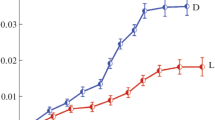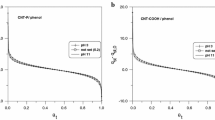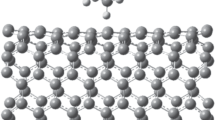Abstract
Adsorption isotherms are obtained for L-histidine on carbon nanotubes using aqueous solutions at temperatures of 25, 35, 45, 55, 65, and 80°C. The isotherms are interpreted by using the cluster adsorption model and analyzing the dependence of the strength of the bond nanotube–amino acid on temperature. Equations of the adsorption isotherms are obtained for all temperatures. The calculated results indicate that L-histidine is fixed on a nanotube’s surface in the form of monomers and different clusters. The equilibrium characteristics of adsorption are found to change as the temperature rises. Values obtained for the coefficients of equilibrium are used to calculate apparent enthalpy ΔH* of L-histidine adsorption by nanotubes, according to the van’t Hoff equation.
Similar content being viewed by others
Avoid common mistakes on your manuscript.
INTRODUCTION
Due to their unique mechanical, electronic, optical, and other properties, carbon nanotubes (CNTs) are a promising material for a variety of nanotechnological applications [1–3]. They are widely used in materials science, biomedicine, and nanoelectronics [4, 5]. The main areas of research in biomedicine include developing tools for targeted drug delivery; creating biosensors, materials for tissue engineering, and means of visualizing biostructures; and finding ways of immobilizing biomolecules on nanotubes [6]. The nature of the interaction between biological molecules and CNTs must be understood for the targeted use of CNTs in biomedicine and molecular biology. Amino acids (AAs) are structural units of many biomolecules and participate in many biochemical processes inside organisms. Analyzing the interaction between CNTs and AAs would seem to be the first step in understanding the effect nanotubes have on biosystems. Such analyses are now performed via quantum chemistry, molecular dynamics, and physicochemical means. These approaches allow us to quantify energies of adsorption, study changes in the structure of a sorbent and sorbate upon adsorption, and identify increases in the dispersibility of nanotubes upon the adsorption of amino acids [7–16]. With aromatic AAs, π–π interactions and van der Waals forces play an important role in the mechanism of adsorption on closed nonfunctionalized CNTs [16, 17]. Despite the many studies of CNT–amino acid systems, there are virtually no works in the literature in which the effect temperature has on the adsorption of amino acids by nanotubes was studied.
The aim of this work was to obtain adsorption isotherms for L-histidine on carbon nanotubes at different temperatures, and to interpret them using the cluster adsorption model we proposed in [18].
EXPERIMENTAL
Constructing Isotherms
Single-walled MKN-SWCNT-S1 carbon nanotubes served as our nanosorbent. L-Histidine (pKСООН = 1.7, \({\text{p}}{{K}_{{{\text{N}}{{{\text{H}}}_{{\text{2}}}}}}}\) = 9.09, pKR = 6.04 at 25°C) was the sorbtive. Characteristics of the materials are presented in Table 1.
The pH values of the solution in each experiment ranged from 7.5 to 8.5, corresponding to the zwitterionic form of the amino acid. The amino acid in an aqueous solution was identified spectrophotometrically on a Shimadzu-1800 spectrophotometer.
Kinetic studies showed that the time needed to reach equilibrium in an amino acid–nanotube–water system is 21 h.
Variable concentrations were used to determine the adsorption capacity of carbon nanotubes with respect to L-histidine. Aqueous suspensions with 0.01 g of CNTs and various concentrations of amino acid were dispersed for 3 min using an MEF91 ultrasonic unit. The suspensions were then placed in an ES-20 incubator shaker and stirred at 25, 35, 45, 55, 65, and 80°C for periods determined in earlier kinetic studies until equilibrium was established. The resulting equilibrium suspensions were centrifuged, and the concentration of amino acid in the supernatant and the amount of adsorbed amino acid were determined. Results are presented as adsorption isotherms.
Cluster Adsorption Model
The model of cluster adsorption used to interpret the isotherms in this work was obtained in [18]. The model describes adsorption as the formation of different sized clusters of the sorbate on surfaces S of the sorbent from monomeric molecules of sorbate A:
The analytical expression for the adsorption isotherm was obtained using the expressions for coefficients Ki of equilibrium in processes (1):
where \({{\theta }_{i}}\) is the fraction of the surface occupied by clusters of i molecules (referred to below as i clusters). \(\sum\nolimits_{i = 1}^n {{{\theta }_{i}}} \) is the share of the occupied surface; \(1 - \sum\nolimits_{i = 1}^n {{{\theta }_{i}}} \) is the fraction of the free surface; n is the maximum size of sorbed clusters; and Ce is the equilibrium concentration of the sorbate in the solution.
The number of molecules in all clusters formed by i molecules, expressed in terms of fraction \({{\theta }_{i}}\) of the occupied surface and the maximum number of landing sites for the sorption of one molecule, were used to derive the isotherm equation. The fraction of the occupied surface was expressed through (2) using coefficients of equilibrium Ki and Ce. This approach produced an adsorption isotherm equation in the form [18]
where q is the level of adsorption; qm is the capacity of a monolayer, mol/g; i (n) is the current (maximum) size of sorbed clusters; and mi is the number of sorbate monomers in the first (lower) layer of a cluster formed by i-molecules.
The parameters of isotherm equation (3) are coefficients Ki of equilibrium for adsorption processes (1), monolayer capacity qm, and structural characteristics i and mi of sorbate clusters. The power to which the concentration is raised denotes the number of molecules in a sorbate cluster, and coefficient \(i{\text{/}}{{m}_{i}}\) before \({{K}_{i}}C_{e}^{i}\) is equal to the ratio of the number of molecules in a cluster of i molecules to the number of molecules in its first layer.
Particular cases of this equation are the Langmuir and BET models [18].
L-Histidine is adsorbed on CNTs through van der Waals forces and π−π interactions between the imidazole ring of the amino acid and CNTs [16]. The π−π interactions between CNTs and histidine are stronger than the stacking interactions between the imidazole rings of the amino acid. This is due to the much greater number of π-electrons in CNTs, relative to histidine. Amino acids do not penetrate into CNT molecules, since the nanotubes that are used have closed ends. In addition, their defects are too small for sorbate molecules to penetrate into them, so all adsorption occurs on the outer surfaces of the nanotubes [16].
RESULTS AND DISCUSSION
General Characteristics of Adsorption Isotherms
Figure 1 shows isotherms obtained for the adsorption of L-histidine from aqueous solutions on MKN-SWCNT-S1 carbon nanotubes (Canada) at different temperatures. At temperatures of 25, 35, 45°C, the isotherms have two plateaus and belong to type IV. At temperatures of 55, 65, and 80°C, they have the form of a sigmoid and belong to type V, according to the IUPAC classification.
The angle of inclination of the initial section of the isotherms falls as the temperature rises, showing that the process is exothermic. According to Le Chatelier’s principle, equilibrium shifts when conditions change in the direction that opposes the change. This means a shift of equilibrium toward the initial substances, increasing desorption and lowering the level of adsorption as the temperature rises, which is observed experimentally. All isotherms have an inflection as the concentration rises.
An analysis of the experimental isotherms shows we can achieve considerable desorption of the analyte by varying only the temperature of an experiment. The technical characteristics of the shaker incubator used in experiments for fixing the temperature do not allow tests at temperatures outside the range of 25 to 80°C. Figure 2 shows the dependence of maximum adsorption (corresponding to Ce near 0.045 M; see Fig. 1) on temperature, obtained from experimental isotherms.
It follows from Fig. 2 that the value of the maximum adsorption falls linearly as the temperature rises. The regression equation has the form
Extrapolating the plot in Fig. 2, we can see that 100% desorption of the amino acid into the external solution is hypothetically possible when T = 121°C. However, this temperature exceeds the boiling point of the aqueous solution. Nevertheless, note that the great dependence of histidine adsorption on temperature allows us to use it for the regeneration of CNTs.
Interpreting Isotherms within the Cluster Adsorption Model
To interpret the isotherms, the parameters of isotherm equation (3) were determined from the condition of the best agreement between theoretical isotherm (3) and experiments (Fig. 1). Calculations show that the isotherm equation for T = 25°C has the form
where qm = 1.70 × 10−2 mol/g; K1 = 49.29 (mol/dm3)−1; K13 = 5.03 × 1020 (mol/dm3)−13, \(~{{R}^{2}} = 0.996\).
Τhe equation that best describes the experimental isotherms at T = 35, 45, 55, 65, and 80°C is
The parameters of isotherm equation (6) for different temperatures are given in Table 2.
The experimental isotherms in Fig. 3 are represented by dots, and the graphs of theoretical isotherms (5) and (6) are represented by the solid curve.
Our data testify to the good agreement between the cluster adsorption model and experiments. Note too that the literature does not sufficiently present the equations of adsorption isotherms of types IV and V according to the IUPAC classification, which include parameters with a clear physical meaning (coefficients of equilibrium of adsorption processes, monolayer capacity, and structural characteristics of sorbed clusters as in the presented model). The model we used allowed us to interpret adsorption isotherms of this form and determine these parameters.
CONCLUSIONS
1. Monolayer capacity and coefficient K1 of equilibrium, which characterizes the adsorption of amino acid monomers, fall as the temperature rises. This is due to the disruption at high temperatures of the weakest sorbent–sorbate interactions and intensification of desorption as the temperature rises. This also explains the change in the shape of the isotherm from convex at T = 25, 35 and 45°C to concave at 55, 65, and 80°C, relative to the x-axis.
2. The degree to which Ce in isotherm equations (5) and (6) is raised denotes the number of molecules in an adsorbed cluster. Only sorbate monomers are adsorbed at low concentrations (Eqs. (5) and (6) include Ce). At high concentrations, sorbate clusters of 7, 8, and 13 molecules form on the surface (Eqs. (5) and (6) include \(C_{e}^{n}\), n = 7, 8, 13).
Adsorption in the form of monomers proceeds on the more reactive regions of nanotubes (e.g., tubes of smaller diameter, ends, defects, and the bends of nanotubes) [19–23]. In less reactive areas (the outer surfaces of tubes with larger diameters), the amino acid is fixed stably only in the form of clusters. This is due to the lower energy of AA adsorption in such areas, relative to the energy of hydrogen bonds that holds the amino acid in solution [16]. There is thus no strong fixation of molecules on the less reactive sites of the nanosorbent, as was shown quantitatively in [16] by means of quantum chemistry. The drop in the energy of the system during adsorption, caused by sorbate–sorbate bonds in addition to sorbent–sorbate interactions, results in its stable fixation when a cluster forms on the surface.
Calculating the Apparent Enthalpy of Adsorption Using the van’t Hoff Equation
The obtained values of coefficient K1 of the equilibrium of sorption characterizing the adsorption of monomers on CNTs at different temperatures were used to calculate apparent enthalpy ΔH* of L-histidine sorption by nanotubes according to the van’t Hoff equation:
Results from calculating ΔH* are presented in Table 3.
Values of ΔH* fall as the temperature rises, due to the exothermicity of histidine adsorption.
CONCLUSIONS
It was established experimentally that the adsorption of L-histidine on carbon nanotubes falls as the temperature rises. This is explained by the weakening of the adsorption bonds between the nanosorbent and the amino acid upon heating, which increases desorption as T rises. Equations of adsorption isotherms were obtained for all temperatures, based on the cluster adsorption model, and their parameters were determined. The equilibrium concentration was included in the isotherm equations as \(C_{e}^{n}\) (n = 1, 7, 8, and 13). Since n is the number of molecules in adsorbed clusters, we concluded that L-histidine is fixed on the nanotube surface in the form of monomers and clusters of 7, 8, and 13 molecules. Calculations showed that the capacity of the monolayer and coefficient K1 of equilibrium, which characterizes the adsorption of amino acid monomers, fall as the temperature rises, which is also explained by the destruction of sorbent–sorbate bonds as T rises. Values of apparent enthalpy ΔH* of L-histidine sorption by nanotubes were calculated according to the van’t Hoff equation. A drop was observed in the values of ΔH* as the temperature rose, due to the exothermicity of histidine adsorption.
REFERENCES
E. G. Rakov, Russ. Chem. Rev. 82, 27 (2013). https://doi.org/10.1070/RC2013v082n01ABEH004227
H. Dai, J. H. Hafner, A. G. Rinzler, et al., Nature (London, U.K.) 384, 147 (1996). https://doi.org/10.1038/384147a0
P. Zhai, J. A. Isaacs, and M. J. Eckelman, Appl. Energy 173, 624 (2016). https://doi.org/10.1016/j.apenergy.2016.04.001
A. Bianco, K. Kostarelos, C. D. Partidos, et al., Chem. Commun., 571 (2005). https://doi.org/10.1039/b410943k
S. Kumar, R. Rani, N. Dilbaghi, et al., Chem. Soc. Rev. 46, 158 (2017). https://doi.org/10.1039/c6cs00517a
L. Zhuang, K. Chen, D. Corrine, et al., Cancer Res. 68, 6652 (2008). https://doi.org/10.1158/0008-5472.CAN-08-1468
A. D. Leon, A. F. Jalbout, and V. A. Basiuk, Chem. Phys. Lett. 457, 185 (2008).https://doi.org/10.1016/j.cplett.2008.03.079
D. Vardanega and F. Picaud, J. Biotechnol. 144, 96 (2009). https://doi.org/10.1016/j.jbiotec.2009.08.016
M. D. Ganji, Diamond Relat. Mater. 18, 662 (2009). https://doi.org/10.1016/j.diamond.2008.11.021
T. Roman, W. A. Dino, H. Nakanishi, and H. Kasai, Eur. Phys. J. D 38, 117 (2006). https://doi.org/10.1140/epjd/e2006-00043-1
L. S. Nechaeva, E. V. Butyrskaya, and S. A. Zapryagaev, J. Struct. Chem. 58, 217 (2017). https://doi.org/10.1134/S0022476617020019
E. V. Butyrskaya, S. A. Zapryagaev, E. A. Izmailova, et al., J. Phys. Chem. C 121, 20524 (2017). https://doi.org/10.1021/acs.jpcc.7b06849
E. V. Butyrskaya, N. V. Belyakova, L. S. Nechaeva, V. A. Shaposhnik, and V. F. Selemenev, Russ. J. Phys. Chem. A 91, 567 (2017). https://doi.org/10.1134/S0036024417030062
E. V. Butyrskaya, L. S. Nechaeva, and S. A. Zapryagaev, Comput. Theor. Chem. 1090, 1 (2016). https://doi.org/10.1016/j.comptc.2016.05.012
L. S. Nechaeva, E. V. Butyrskaya, and S. A. Zapryagaev, Russ. J. Gen. Chem. 86, 1684 (2016).
D. T. Le, E. V. Butyrskaya, and T. V. Eliseeva, Russ. J. Phys. Chem. A 95, 2280 (2021). https://doi.org/10.1134/S003602442111011X
P. Lingyu, L. Quanrun, and L. Yongdan, J. Phys. Chem. C 116, 1724 (2012). https://doi.org/10.1021/jp2085318
E. V. Butyrskaya, S. A. Zapryagaev, and E. A. Izmailova, Carbon 143, 276 (2019). https://doi.org/10.1016/j.carbon.2018.10.086
E. R. Badamshina, M. P. Gafurova, and Ya. I. Estrin, Russ. Chem. Rev. 79, 945 (2010). https://doi.org/10.1070/RC2010v079n11ABEH004114
P. Seongjun, S. Deepak, and C. Kyeongjae, Nano Lett. 3, 1273 (2003). https://doi.org/10.1021/nl0342747
O. Gulseren, T. Yildirim, and S. Ciraci, Phys. Rev. Lett. 87 (11) (2001). https://doi.org/10.1103/PhysRevLett.87.116802
D. W. Schaefer and R. S. Justice, Macromolecules 40, 8501 (2007). https://doi.org/10.1021/ma070356w
E. G. Rakov, Russ. Chem. Rev. 82, 538 (2013). https://doi.org/10.1070/RC2013v082n06ABEH004340
Funding
This work was supported by the RF Ministry of Science and Higher Education as part of a State Task for universities in the field of scientific activity, 2020–2022; project no. FZGU-2020-0044.
Author information
Authors and Affiliations
Corresponding authors
Rights and permissions
Open Access. This article is licensed under a Creative Commons Attribution 4.0 International License, which permits use, sharing, adaptation, distribution and reproduction in any medium or format, as long as you give appropriate credit to the original author(s) and the source, provide a link to the Creative Commons license, and indicate if changes were made. The images or other third party material in this article are included in the article’s Creative Commons license, unless indicated otherwise in a credit line to the material. If material is not included in the article’s Creative Commons license and your intended use is not permitted by statutory regulation or exceeds the permitted use, you will need to obtain permission directly from the copyright holder. To view a copy of this license, visit http://creativecommons.org/licenses/by/4.0/.
About this article
Cite this article
Le, D.T., Butyrskaya, E.V. & Eliseeva, T.V. Cluster Adsorption of L-Histidine on Carbon Nanotubes in Aqueous Solutions at Different Temperatures. Russ. J. Phys. Chem. 96, 1719–1723 (2022). https://doi.org/10.1134/S003602442208012X
Received:
Revised:
Accepted:
Published:
Issue Date:
DOI: https://doi.org/10.1134/S003602442208012X







